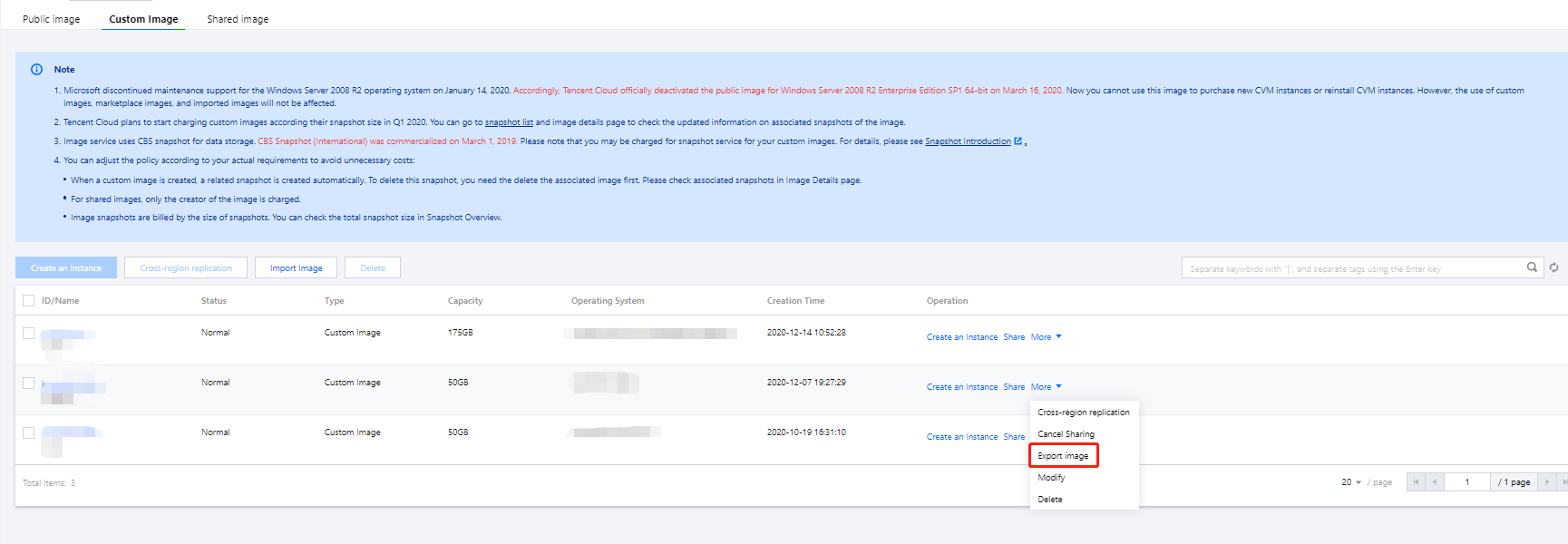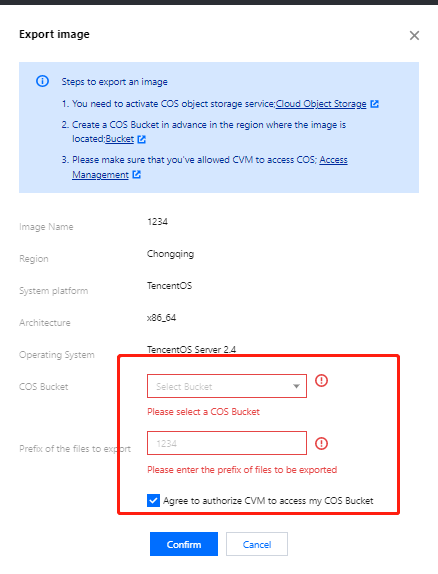导出镜像
最后更新时间:2024-01-08 09:37:01
操作场景
前提条件
已前往 对象存储控制台 开通对象存储服务。
已在自定义镜像所在地域创建存储桶,详情请参见 创建存储桶。
注意事项
商业版镜像不支持导出,如 Windows 镜像。
自定义镜像的系统盘及数据盘单块容量不能大于500GB。
导出整机镜像时,数据盘不能大于5块。
费用说明
若在使用云服务器时,同时使用了其他产品。例如对象存储 COS,则将按照实际使用产品的计费规则进行费用计算。
费用说明如下表:
场景 | 产生费用 | 说明文档 |
导出镜像到 COS 存储桶 | 存储容量费用。镜像存储在 COS 存储桶,会产生存储容量费用。COS 会计算对象大小,按照目标对象的存储类型和所属地域计费。 | |
| 请求费用。导出镜像到 COS 存储桶,会产生写请求费用。COS 会计算写请求次数,并收取请求费用。 | |
| 流量费用。导出镜像到 COS 存储桶,会产生上行流量。COS 会计算流量大小,内网上行流量、外网上行流量均免费。 | |
从 COS 存储桶下载镜像 | 请求费用。从 COS 存储桶下载镜像,会产生写请求费用。COS 会计算写请求次数,并收取请求费用。 | |
| 流量费用。从 COS 存储桶下载镜像,会产生下行流量。COS 会计算流量大小,内网下行流量免费、外网下行流量收费。 | |
操作步骤
1. 登录云服务器控制台,选择左侧导航栏中的 镜像。
2. 在镜像页面上方,选择需导出的自定义镜像所在地域,并单击自定义镜像页签。
3. 选择镜像所在行右侧的更多 > 导出镜像。如下图所示:


4. 在弹出的导出镜像窗口中,进行以下设置。如下图所示:


COS Bucket:选择导出镜像所在的存储桶,需与镜像在同一地域。
导出文件前缀名:自定义导出文件前缀名。
勾选“同意授权CVM访问我的COS Bucket”。
5. 单击确定,即可开始镜像导出任务。
6. 在弹出的确认窗口中单击确定。
导出时间取决于镜像的大小和任务队列的繁忙程度,请耐心等待。导出任务完成后,镜像文件将会存放在目标存储桶中。您可前往 存储桶列表 页面,单击存储桶 ID 进入详情页面,名为
自定义前缀名_xvda.raw 的文件即为导出的镜像文件。相关问题
1. COS 的外网下行流量如何产生的?如何收费?
外网下行流量是数据通过互联网从 COS 传输到客户端产生的流量。用户直接通过对象链接下载对象或通过静态网站源站浏览对象产生的流量属于外网下行流量,对应费用为外网下行流量费用。外网下行流量计费详细信息请参见 计费项 和 产品定价。
2. 通过 COS 的控制台、工具、API、SDK 方式下载文件会产生外网下行流量费用吗?
3. COS 如何区分外网流量?
外网下行流量指数据通过互联网从 COS 传输到客户端产生的流量。例如通过 COS 控制台下载存储在 COS 中的文件,通过工具访问对象、下载对象,或使用浏览器预览对象,使用对象地址或自定义域名访问和下载对象等均会产生外网下行流量 。详情请参见 内网与外网访问判断 文档。
4. 对象存储使用内网访问是否会产生费用?
文档反馈

